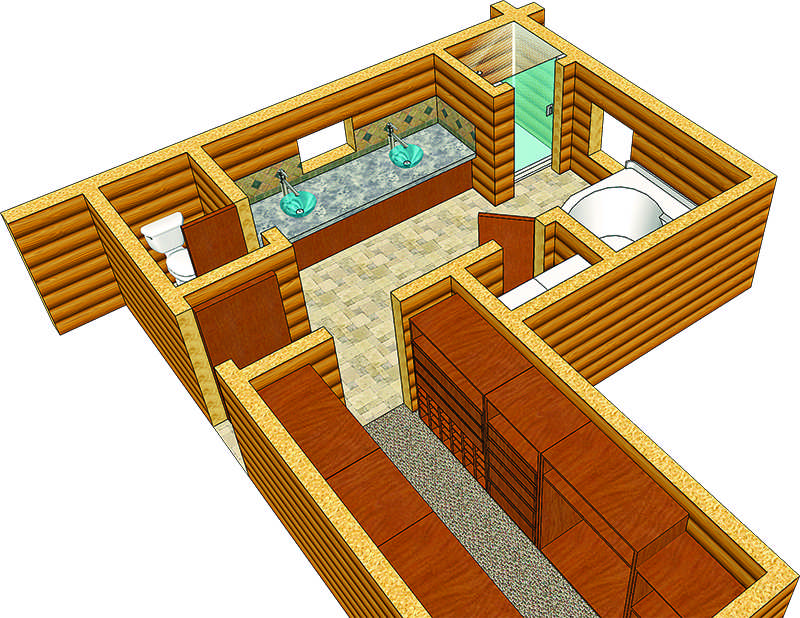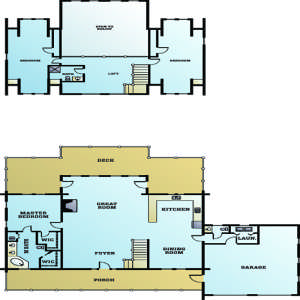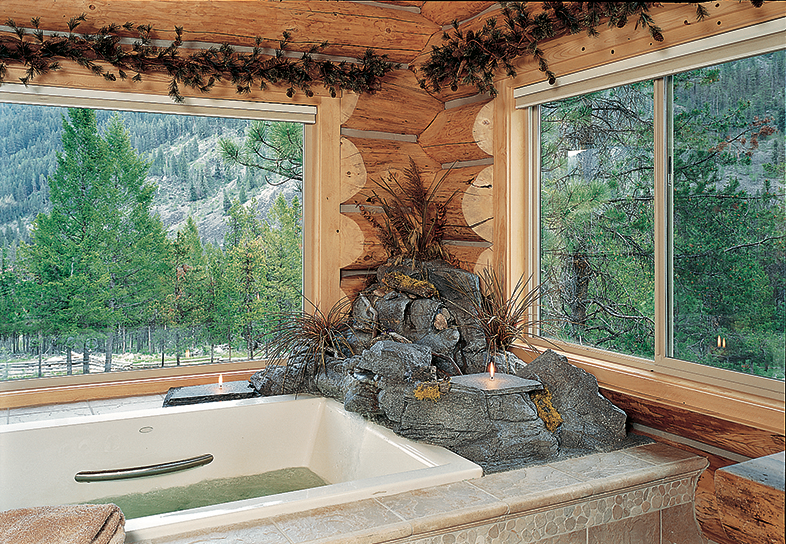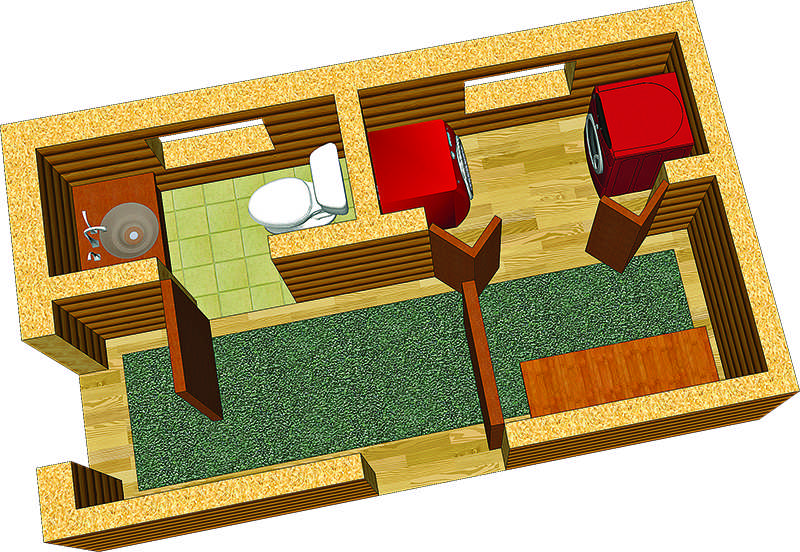By Mercedes Hayes
I find bathrooms to be the most difficult rooms of the house to conceptualize. After all, with the exception of your kitchen, the bathroom has the most complicated plan and must withstand multiple functions and frequent use.
We’ve all read great articles and have seen TV shows touting beautiful bathrooms, but these often focus on accessories. Gorgeous granite and fantastic fixtures make for a stunning space, however, that’s the end of the design phase. What about function?
Here are a few points to consider as you plan the bathroom of your dreams:
Location
It’s expected that the master bedroom comes with an en suite. That’s a no brainer. But where to place the rest of the bathrooms in the house?
Subsequent bedrooms can share bathrooms, depending on the occupants. If your home calls for an in-law suite, you will likely want a dedicated bathroom there. Young kids share bathrooms quite easily, but what happens when they are teenagers? Will dedicating separate baths now help ease family tensions later on?
Bedrooms aside, it’s the location of the powder room that can make or break a floor plan. It’s one of the smallest rooms in the house, but locating it correctly is a huge consideration. Too close to the kitchen is a definite turn off. Open access to the great room or dining room is just as uncomfortable.
Siting them near the entryway or tucked into a mudroom can provide the equal parts of easy access and privacy that everyone wants. Wherever they are positioned in the plan, bathrooms should maximize access to the waterline, which brings us to our next consideration: plumbing.
Plumbing
Any contractor will tell you that the best floor plans position the bathrooms so that the plumbing runs will be the shortest possible.
They recommend placing two bathrooms back-to-back, or one above the other. Or perhaps you could line up a bathroom next to (or above) the kitchen. What you want to avoid, if possible, is placing an upstairs bathroom on the other side of the structure from the rest of the plumbing. This creates a situation where the pipes will have to snake across the house.
Not only will you spend more money on the extra hardware required to span the distance, you open yourself up to more complicated, invasive and costly repairs should your plumbing system ever fail.
Traditional log home construction presents unique plumbing challenges. For instance, are you planning to make your upstairs wood floor pull double duty as the wood ceiling below? It’s a beautiful log home look, but it makes it tougher to conceal the pipes.
Some people build a box between the beams below the toilet and tub. I have even seen portions of the bathroom floor raised (think elevated porcelain throne) or even the entire floor raised (stepping up into the bathroom). Though they do present solutions, they tend to be visually disruptive and pose potential toe-stubbing threats during a midnight run to the facilities.
A common mistake is to forget to provide access to the bathtub pipes. Do you put in an access panel through an interior wall? Perhaps a solution would be to build a knee-wall with access (for a standard tub).
Or you might choose a tub with an enclosure; a Jacuzzi tub that you climb into comes to mind.
Ceilings
Many log homes have steeply pitched roofs—particularly in areas with a high snow loads—and though necessary and beautiful, they can wreak havoc on second-story-bathroom functionality.
Are you putting your second-floor bathroom under a slanted ceiling? How will you position the shower?
If the ceiling restricts headroom, it’s wise to put the shower against an interior wall where the ceiling height will be at its max. A wide dormer presents a great spot to position a bathtub, both from aesthetic and practical points of view. What about the toilet?
If your space is restricted, you might be able to get away with placing the toilet under the slant since you won’t be standing on it, but designers featured on houzz.com agree that you shouldn’t place the toilet under anything less than 5 feet of headroom. If you have less than 5 feet, opt to use this space for storage instead. What kind of light fixtures are you considering?
If you want to use a hanging pendant or chandelier over the tub, check your local building codes. I needed a ceiling high enough so you couldn’t touch the light when standing in a tub full of water (why I would do that, I don’t know).
Lighting
And speaking of lighting, make sure your bathrooms will have plenty of it—both artificial and natural.
If positioning the bathroom to take advantage of an exterior window isn’t possible, consider a skylight. Enlist an overhead fixture (or two) that’s sized to shed the appropriate amount of illumination for your room’s square footage.
And having enough wall-mounted lighting around mirrors and elsewhere in the room is essential for functions like makeup application and shaving. Develop your lighting plan early to ensure you have the right amount of wiring placed in all the right locations.
 How many sinks do I need? Does my commode need to be self-contained? Do I need a stand-alone shower? These are a few factors to consider when planning a bathroom.
How many sinks do I need? Does my commode need to be self-contained? Do I need a stand-alone shower? These are a few factors to consider when planning a bathroom.
Layout
I had a hard time deciding where to place the toilet in relation to the shower and vanity. Do you want the toilet contained within its own room?
This option gives you maximum privacy but it takes a fair amount of extra space. Would a knee-wall suffice to isolate the toilet from the rest of the room (with perhaps a tub on the other side of it to access the plumbing).
Do you need to isolate it at all? A long galley-style bathroom requiring you to line up the fixtures side by side may be functional, but usually doesn’t look appealing. If you and your spouse need to use the room at the same time, you might trip over each other, which will take away from its usability and cause stress.
Square-shaped bathrooms are pretty to look at but eat up a little more floor space. In the case of a master bath, it may cause you to reallocate some of the bedroom’s square footage to accommodate it. Perhaps employing an “L” shape and putting the shower into the shorter section would give you a more useful and attractive space. Your shower could share a wall with a closet.
 Smartly designed homes position bathrooms so that the plumbing lines are the shortest. Here, a powder room shares direct waterlines with the laundry and the kitchen.
Smartly designed homes position bathrooms so that the plumbing lines are the shortest. Here, a powder room shares direct waterlines with the laundry and the kitchen.
And how about that closet? In addition to the requisite linen closet, some people attach their walk-in closet to the master bathroom instead of the bedroom.
And then there are the other bathrooms in your log abode. If budget allows, expert designers recommend each bedroom have its own en suite—both for convenience and resale. But for many, that’s not practical from space or budgetary considerations.
Depending on the number (and age) of the other occupants, a Jack-and-Jill pass-through bath connecting the bedrooms works nicely. It is typically laid out galley style. Powder rooms don’t have to be large but they do have to have room to maneuver.
According to residential building codes, toilets require a minimum clearance. This can vary based on local specs, but the most common code requirement is 15 inches of unobstructed space on either side of the toilet’s centerline and at least 24 inches in front of the bowl, either to the wall or another object.
Then you have to factor in the sink, which can vary from a simple pedestal to an elegant vanity to a rustic barrel. Take your fixtures into consideration when you are allocating space to each bathroom, not just the powder room. Regardless of which bathroom it is, be aware of door swings.
Have you given enough clearance for the door? There’s nothing worse than the door banging into the vanity or making it a tight squeeze to access the commode closet. If space is tight, you have options. Perhaps a pocket door or a cool barn-style door that rolls on an exposed track would serve if you have a clearance crunch.
Knowing the size of the fixtures you want during the design phase will help you plan successfully. When you and your log home manufacturer review your plan, make sure the bathrooms’ locations will not negatively impact the log package, whether it has to do with cost, potential moisture issues or other factors.
Getting their opinion will reap dividends for your future log home happiness.














